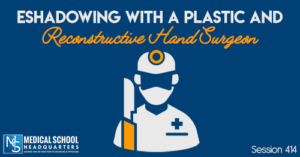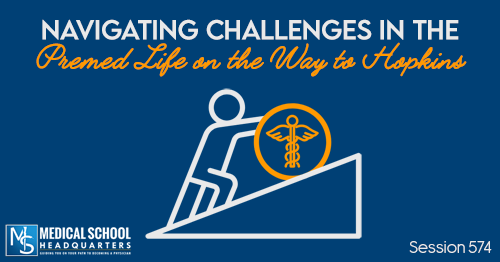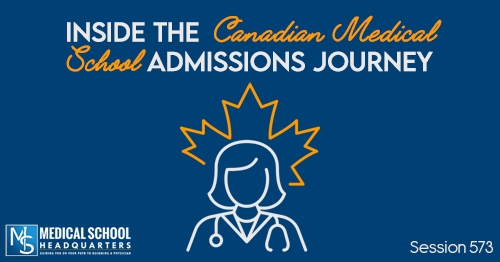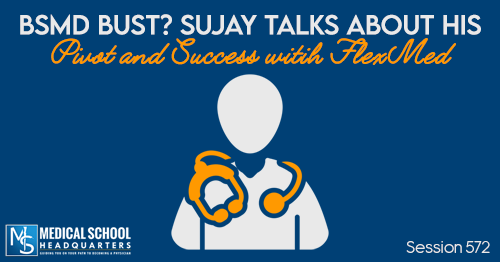Apple Podcasts | Google Podcasts
Session 414
Dr. Michael Galvez joins on the first session of eShadowing. Don’t forget to check out eShadowing.com for shadowing during COVID.
Michael is a Plastic and Reconstructive Surgeon and a fellowship-trained Hand Surgeon. He had a lot of great cases that he covered that had a lot of visual things. Again, this is a shadowing session with Dr. Michael Galvez. Find him on Instagram @michaelgalvezmd and Twitter @michaelgalvezmd. Or go to premed.TV to watch this session if you want to see some of the pictures of the surgeries Dr. Galvez is doing.
Find out more about this specialty by visiting acaplasticsurgeons.org and follow them on Instagram: @acapsedu.
For more podcast resources to help you along your journey to medical school and beyond, check out Meded Media.
Listen to this podcast episode with the player above, or keep reading for the highlights and takeaway points.
[01:19] A Look into eShadowing.com
This is a special episode of The Premed Years as we share with you an episode of our new eShadowing series. One of the most common questions I’m getting right now during this pandemic is how can I get shadowing experience when no one is letting me shadow.
Well, there is probably not going to be any shadowing for a while because of COVID-19. And there have been a few virtual shadowing opportunities that have popped up. And so I started eShadowing every Monday 8 pm Eastern on eShadowing.com.
We have had over 2,000 students show up live every week with up to 10,000 students registering to even watch the replay. A lot of the shadowing experiences don’t allow you to watch a replay and still earn credit. By credit, we mean an hour of each shadowing, which you can earn toward a certificate. You don’t have to show up to a specific number of eShadowing sessions to get a certificate, which will have your total hours earned.
The replay for credit is available through Sunday night every week. Again, the live session is 8pm Eastern every Monday, and you can watch the replay through Sunday night. There is a quiz that you have to take and pass and you only get one chance at passing the quiz. Passing rate is 80% or four out of five. So it takes 45 minutes of watch time for the session and passing the quiz to earn an hour of shadowing credit.
We’re also starting eShadowing for pre-PA students, held on Mondays at 7 pm Eastern. It will be hosted by Rodeline Joseph, who is a PA and the founder of Medsembly which you can also find on Instagram @medsembly.
[06:24] A Day in the Life of a Plastic Surgeon
'When you think of plastic surgeons, it's no one's fault you think of cosmetic plastic surgery.'Click To TweetMichael is a plastic surgeon and he’s a hand surgeon. He focuses on treating children with plastic surgery and hand problems. He works at a hospital in the Central Valley. He sees a lot of different diagnoses that children can have, whether it’s trauma, congenital, or injuries.
[10:20] What is a Plastic Surgeon?
Plastic is derived from the Greek word plastikos which means moldable. One of the first plastic surgeons was Dr. Gaspare Tagliacozzi from Italy. At that time, he had many patients with nose deformities. He figured out a way to treat that deformity through surgery. He removed a little piece of tissue from the arm, which he connected to the nose. And he let it stay there for about three weeks. Then he divided that piece of tissue from the arm and that tissue that was connected would survive.
Plastic surgeons treat patients from head to toe. They’re a surgeon’s surgeon. They focus on not only the form of what things look like, but also the function. Plastic surgery encompasses aesthetics, craniofacial trauma, cleft lip and palate, craniofacial deformities, lower extremity trunk burns, breast reconstruction for patients that have breast deformities or breast cancer, and then hand and upper extremity.
'Be wary about what you see on social media because it usually doesn't truly depict the field well.'Click To Tweet[14:09] What It Takes to Become a Good Plastic Surgeon
Michael did community college, Berkeley, two years of research, and then medical school and residency. Figure out where you fit in. It’s not just about being a good surgeon and being skilled. You have to be able to communicate well with people. You want to have the knowledge and the skill. And if you want to do it, you can do it.
'No one ever said it was going to be easy. It's a surgical field. And so it requires a lot of dedication.'Click To TweetBy being well prepared and well-trained, you can hopefully anticipate any problems that can come up. And whether you’re making this right incision is something where you can build that confidence over time. Any human with two hands, as a hand surgeon, can train how to use them to help people, to fix things, to be a carpenter, to be a surgeon. It’s very doable.
'If you have the hands, and you have the knowledge and the heart for it, you can really make a difference.'Click To TweetIf you believe it, you shoot for it, and you have mentorship, it’s possible. and that being said, it’s competitive. You want to get into a top medical school. And the reason for that is that it comes down to opportunity.
Moreover, research is important as well as shadowing. Again, you want to make sure it’s the right fit. It’s a big commitment because that’s six to seven years. So mentorship is also important. There’s no cookie cutter approach. You could do well on the boards but you could end up dropping it if it’s not the right fit.
It comes down to opportunity. You have to go out of your way to find a mentor and you can make it possible.
[17:13] The 2 Main Tracks in Residency
- Independent Model – You do general surgery first, and then a fellowship. This could take up to 10 years.
- Integrated Model – This can take from five to six years. For surgical residency, first year’s intern. Then in the other years in residency, you get graduated responsibility. You do rotations in different settings.
During residency, you usually start before 6 am sometimes and you end late in the evening. You round in the morning on your patients, do surgeries, and then in the evening, you check on them. The call is challenging. There’s a lot of learning, teaching didactic, conferences, hands-on workshops. The operations can be from simple to super complex. You do yearly exams.
[20:38] Fellowship Trainings
-
- Hand surgery – To do hand surgery, you can come from any background related to the field (ex. orthopedics, plastic surgery and general surgery).
- Cranial facial microsurgery – Microsurgery is when you transplant tissue from the same person to other parts of their body.
- Cosmetic fellowship
Once you’re done training, you have to collect cases over a period of time. You have to take photos of every case and get consent from the patient for the photos. It’s focused on safety. They want to make sure that the plastic surgeons being made are being safe.
[22:35] What His Work Looks Like
Michael does clinic for two days and two days of O.R. He is developing a new program at their institution so he’s trying to work on research as well. He works 50-60 hours a week, sometimes a lot more. He’s on call every four days for hand surgery and craniofacial problems as well as he’s a plastic surgeon.
[23:03] Types of Patients
Michael treats patients from newborns up to age 18. It’s a discussion with the family and the guardian. It’s an essential part of the care he provides. They have social workers as well as hand therapists. 75% of the patients he treats are medically insured.
'It's an underserved population that's quite diverse.'Click To Tweet[23:32] Case #1: Complex Craniofacial Problem
Scenario:
A 12-year-old boy comes to the ER. He was unrestrained. He wasn’t wearing a seatbelt. It was early in the morning. And it sounds like a blast or a glass and part of the door actually went into his face. The ER calls you and tells you that his face is just split open. And so what do you want to know first besides the problem at hand? What do you want to know about this young boy?
'This is the whole thing about being a doctor. Who cares how much you know about the book, if you can't ask the basic questions?'Click To TweetBasic Questions to Ask:
- What happened?
- What was the mechanism? (ex. he’s got an open wound)
- Is this patient stable?
- The ABC’s (airway, breathing, and circulation)
- Are they breathing okay?
- Are there any airway issues?
- Is the heart stable?
Things to Consider:
- The patient has an open wound so you want to think about antibiotics.
- Know if a trauma surgeon has seen him. You’re a plastic surgeon so you’re focused on the face. But a trauma surgeon is looking at this patient head-to-toe to make sure there are no other serious injuries.
Other questions you need to answer:
- Does he have a head injury?
- Is his neck injured? (If you’re going to be moving his head during the case, you better make sure he doesn’t have a neck injury.)
- Is his tetanus up-to-date?
- Does he have any other medical problems that are relevant?
[26:33] How to Examine
Initial injury: The young boy has got a laceration of the eyebrow and a deep laceration involving the sidewall of his nose and going down to his lip. And you can actually see inside of his nose through there, and you can see bone.
- Make sure he can open his eyes that may be swollen, but that his vision is okay
- The wound – examine the muscle structure of his eyebrows if he can elevate them.
- Look inside of his nose to see if there’s any bleeding in the septum.
- Then get more imaging – get a CT scan.
[28:57] Diagnosis
The patient has an open to air fracture of the craniofacial skeleton. Look at all the craniofacial skeletons. Make sure he doesn’t have a fracture up there and make sure he doesn’t have significant fractures of the maxilla, of the zygoma (cheekbones), of his mandible.
Based on the picture Michael showed, you can see there’s a big giant crack and a displacement. This entire piece is inferiorly downward displaced and going into the orbital floor. This is actually called the nasal orbital ethmoid (NOE) fracture. There’s a classification where his fracture was so bad that the attachment of the eyelid was completely off and so it actually looked like his eye was shifting over because the eyelid was off.
Michael also shows more pictures of the fractures broken into several pieces. The patient was stable and didn’t have any other injuries so this is isolated.
In training, you become very used to looking at it in specific planes, like taking and cutting out of it in all three planes in three dimensions. This is a 3D reconstruction of fine cuts of that CT scan. And you can actually rotate it, look at it around. You can even 3D print it sometimes. It can help with operative planning.
[31:03] Treatment Options
Option #1: Do nothing. But the problem with that is the orbit. The eye sits in the orbit. If there’s more space in the orbit, that you can actually sink off or move off to the side. And this patient also had that tendon from the eyelid that was torn. If you didn’t treat that, the patient would have a pretty significant deformity.
Option #2: Operative.
- Taking the patient to the ER, and discussing the risks and benefits of this.
- Washing out the wound – the most important thing is that this kid doesn’t get infection
- Reducing the bone and putting it back in place
- Putting small plates with screws that are literally small titanium plates with screws
[31:54] Other Aspects of the Injury
'Safety is really important. We want to make patients better. We don't want patients to have a bad outcome.'Click To TweetThink about general anesthesia. Tell the family that the patient will require general anesthesia. Bleeding is always possible and infection. The plates can have issues. And doing the surgery, he could injure his eye and the patient could become blind. That would be very unusual though. But anything is possible when you have sharp objects around a specific area.
The anatomy is super complex because there are so many layers to it. Most people see just the skin. But as a plastic surgeon, you’re thinking of all the tissue in every aspect of it, in significant detail that nobody else knows.
For example, above the eye in the medial or central part of the eye, there are two arteries right there which only the plastic surgeons would know about. And it just comes down to the level of detail because sometimes they have to use those arteries to bring tissue over that has blood supply. Between those bones are sutures. That’s how the bone developed. And previously, the bone would grow from somebody’s sutures.
The orbit is really complex. There are seven bones in here that Michael has to think about. All these bones are relevant. Because you’re going to be in that area, you should know exactly that this fracture is going through this part through the lacrimal bone likely and then through the infraorbital rim.
Michael also explains how the kid’s drainage system for the eye was completely cut. And so that had to be repaired. He had to put in a little silicone tube through the bottom punctum and the superior pump, which comes out through the nose, and then you tie it in the nose. And then you have to take it out of a separate surgery once everything heals.
In other words, a lot of things had to be considered in order to fix them. If you don’t fix one of these things, he would permanently not be able to fully drain his eye. He would always be tearing in his eye for the rest of his life. Or if the campus wasn’t repaired, he would have a permanent deformity.
[36:25] Result
Michael has a video where he was pulling the actual tendons showing he was putting it back in place and he sutured it back in place. He was able to repair those things, with the silicone stent and repairing the campus with the permanent suture with plating the bones and then repairing the skin.
Michael presents a picture of what the patient looked like at the end of the case. He also shows a picture of the patient six to eight months later, and he’s done great. And so luckily, things went well for this child.
This is a fairly complex craniofacial problem that has been closed quickly. Otherwise, if you didn’t think about the orbital floor, or if you didn’t think about repairing the drainage system, there would be significant deformities and functional problems for this child.
The case lasted for about four to five hours.
[38:09] How to Deal with the Parents
You have to read the parent in this trauma situation, especially like this mom was woken up. This kid was coming home early in the morning with a sibling, and she was woken up with this, that he’s been severely injured. He’s been helicoptered over to this other hospital. And she had to drive a few hours to come to the hospital. And so, you really have to put yourself in the position of the family member.
'The whole key thing with being a physician, in my opinion, and in the world, in general, is to have empathy.'Click To TweetThe mother was Spanish-speaking only. And Michael was able to communicate with her. It’s very traumatic for parents or for anybody who hasn’t seen it. They’ve raised this child their entire life. This child has been perfect and beautiful. And now they’re worried, first of all, that the patient could die and that the patient is going to be permanently disfigured. In this case, the mom was more worried about him dying, which is very reasonable.
You also have to say things in simpler terms. Even the word fracture is not a great word because many people don’t understand it. You just have to say broken bone.
[41:27] Case #2: Amniotic Band Syndrome
Scenario:
An 18-month-old child comes in with the mom. The child is missing the left index finger and the child was born that way. And if you look closely on the middle finger here, and the thumb, there’s these really deep bands going into the fingers.
Basic questions to ask:
- Were there any issues during the pregnancy?
- Is there any family history of congenital hand differences?
- Does the child have any other medical problems?
- How does the child use the specific hand? (functional questions)
[43:39] Examining the Imaging: Diagnosis
If you look closely at the X-ray imaging, there’s an amputation at the level of the index or proximal phalanx. And if you look in this band, look at the difference between the one on the middle finger and the ring finger, you can see that that bone is being squished. It’s like a tourniquet effect.
It’s called an amniotic band syndrome. It’s thought to be from amniotic bands in the development of the child, where it wraps around parts of the hand, the legs, even the face. Cleft lip is typically from other factors, but it can cause cleft type deformities.
The incidence is not that common, it’s about one in 2,000, to one in 15,000. It’s more common in African-American, and 60% of patients can have an abnormal gestational history, which means something was different during the gestation, whether the child is premature or lower birth weight or some type of trauma. And sometimes it’s completely random.
What they usually tell families is that it’s intrinsic, which essentially says that there’s something in development that causes it to be. Sometimes, some of the tissue can be acutely ischemic. Acutely means right on the spot. And ischemic means where there’s not enough blood supply, where you have to go in and do more emergent surgery on a newborn.
[47:10] Treatment Options
Option #1: Do nothing. Just observe and think how you can individualize their treatment. The whole goal is to correct this before, and to get to it earlier on so that it doesn’t become a worsening deformity. Discuss the risks and benefits and things that you can do.
'You want to prevent worsening deformity.' Click To TweetOption #2: Z-plasty
When you have a band that’s tight, the Z plasty is a basic principle in plastic surgery. If you draw two flaps, at 60 degrees, you can size it, which means cut it with just the skin, cut it with the blade, elevate those flaps, and then reverse them and flip them.
They’ve done studies showing that if you do 60 degrees, it can increase the length by 75%. This is where math is important. You should be able to understand and think about these things because these are real things you’re doing on the human body to help.
Another important consideration is the band goes all the way around the thumb. But if he makes cuts all the way around the thumb, there’s two blood vessels that are going into the thumb. So the central limb was now extended and they improved the contour.
[50:22] Things to Discuss with the Family
You want to say that there is constriction and that you can improve this, but the patient will have scars. The hope is that as the child grows, the finger will be more normal and hopefully, will not have a worsening deformity.
Since they’re kids and they’re moving all the time, they’d usually cast the patients for better healing. Healing takes place in about four months. As a result, the tight band is not there as much.
Another thing you can talk about is you can do things like transplanting toes to the hand to provide function. You could even remove this bone if it’s getting in the way with grasping objects, but the child is doing fine.
[53:04] Case #3: Soft Tissue Surgery
Scenario:
A four-year-old, two years after a friction burn, and just had wound care. She didn’t require surgery. But over time, the fingers just contracted down. And so this is how she presents to Michael’s clinic. Her middle finger is fairly bent down. And there’s this big tight band of the middle finger, and then there’s also a band of the ring finger. She can’t put her hand, totally flat, going back.
Basic questions:
Were there any other injuries deeper on there? So you would get an X-ray, and examine the patient. Think about all the tissue.
The X-ray shows that the fingers bent from the scar tissue, from the burn, but the bones are normal. So this becomes a soft tissue surgery.
[53:52] Treatment Options
Option #1: Do nothing. But the problem is that as the child grows, that’s just going to get worse from the scar tissue. And so you want to think about treatment for this patient.
Option #2: double opposing Z-plasty
Based on the picture, you can see a z there, and a z there. And when you cut all these, it turns into what we call the jump man. And once you transpose these flaps, it spreads and deepens the tissue. All the limbs are the same, cutting it with the skin with the knife. They do this under tourniquet so you can see really well. And then transposing so these two flaps up here went down into that space.
It was just a straight incision with care to not injure the nerve and the blood vessel, and then taking a little skin graft from the side of the hand, and placing it right on that middle finger. She has a metal pin to hold it while it heals. Because if he puts a skin graft and she starts moving it, it’s not going to heal.
Healing took place in about three to four months.
[58:59] Final Words of Wisdom
When you become a board-certified plastic surgeon, you still have to take a test every seven to 10 years, where you get tested on all these things to make sure that you’re safe, and that you’re knowledgeable about how to take care of them. If there’s something that is so complex that you can’t take care of it, you’ll know who to contact so keep up with those principles.
“When you choose a surgery residency, it affects everybody. It affects your family. It affects your lifestyle. You really do want to think about it.”Click To TweetYou want to make sure that you’ve asked all the questions that you’ve shadowed. Have the due diligence to make sure that it’s the right fit for you.
Links:
Instagram: @acapsedu
Instagram: @ValleyChildrensHands
Instagram: @michaelgalvezmd
Twitter: Twitter @michaelgalvezmd
Instagram @medsembly












